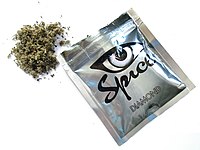
Photo from wikipedia
Urinalysis is well established for drug screening. Various methods of urine adulteration such as dilution, addition of oxidative/reductive chemicals or detergents, and handing over urine-like fluids are used to circumvent… Click to show full abstract
Urinalysis is well established for drug screening. Various methods of urine adulteration such as dilution, addition of oxidative/reductive chemicals or detergents, and handing over urine-like fluids are used to circumvent a positive screen. Validity parameters such as determination of pH, gravidity, urine temperature, or testing for oxidative/reductive chemicals are therefore used to uncover adulterated urine specimens. However, synthetic urine ("fake urine") has nowadays been used for manipulations, leading to inconspicuous results with common validity test systems. Therefore, the aims of the study were (a) to evaluate additional validity parameters, (b) to evaluate the prevalence of urine adulteration, (c) to identify adulteration markers in purchased fake urine samples. Urine samples (n = 550) submitted for drug abstinence testing were analyzed by a standard urine liquid chromatography-tandem mass spectrometry (LC-MS/MS) screening approach using library-assisted identification of 10 different endogenous biomolecules. The detection rates of biomolecules in authentic samples were phenylalanine (93.4%), tryptophan (97.1%), propionyl-carnitine (67.1%), butyryl-carnitine (99.6%), isovaleryl-carnitine (92.8%), hexanoyl-carnitine (91.0%), heptanoyl-carnitine (97.1%), octanoyl-carnitine (98.9%), and indoleacetylglutamine (98,2%). Phenylacetylglutamine was detected in each authentic sample. Based on the detection rates and measured creatinine levels, six manipulated samples were identified in this study. In two cases, fake urine was handed over, one time fake urine was most likely used for dilution. Once dilution with other fluids was used as adulteration method, while in another sample a detergent solution was handed over. Additionaly, one sample contained reactive chemicals. All fake urine samples were additionally identified by the detection of unique polyglycole patterns, which were observed in purchased fake urine samples.
Journal Title: Drug testing and analysis
Year Published: 2018
Link to full text (if available)
Share on Social Media: Sign Up to like & get
recommendations!